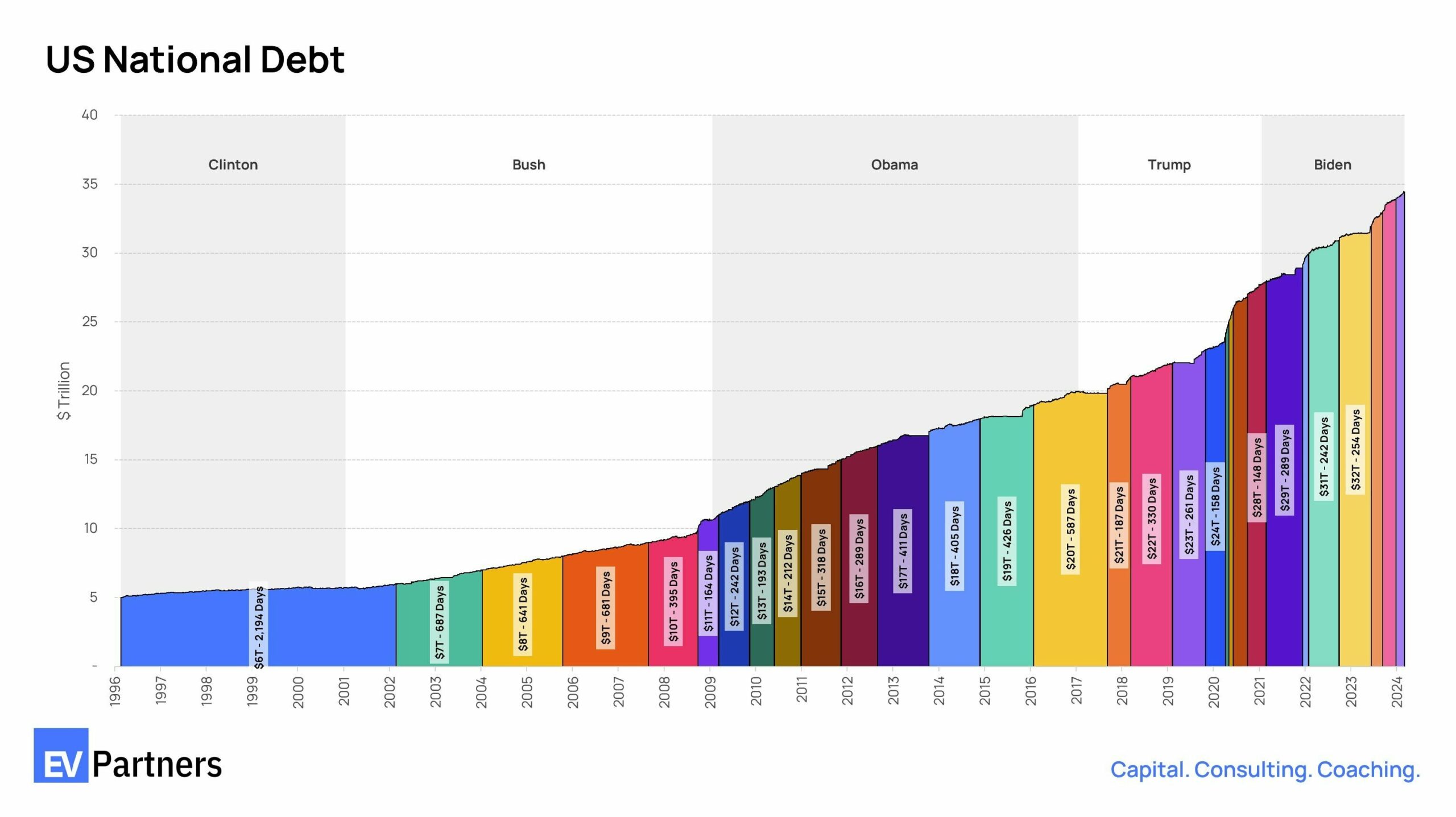- The United States is facing an alarming increase in its national debt, adding one trillion dollars every 90-120 days.
- The national debt is a bipartisan issue that has escalated since the presidency of George W. Bush, with factors such as military spending and tax cuts contributing to its growth.
- Bitcoin could serve as a safeguard against excessive deficit spending and promote financial discipline, potentially mitigating the risks associated with the growing national debt.
The United States is currently facing an unprecedented financial challenge marked by the rapid growth of its national debt. This article delves into the concerning trajectory of the national debt, the bipartisan nature of the issue, and the potential consequences for the U.S. economy. Additionally, we will explore the role of Bitcoin as a potential safeguard against excessive deficit spending and its implications for the financial stability of the nation.

The Escalating National Debt
The trajectory of the national debt is both striking and concerning. The addition of each trillion dollars to the debt is represented by a distinct color on a chart, highlighting the magnitude of the problem. Not long ago, it took six years to add a trillion dollars to the debt. However, the pace has accelerated significantly in recent years. Currently, the U.S. is adding one trillion dollars to the debt every 90-120 days.
A Bipartisan Phenomenon
The explosion of the national debt has transcended political affiliations, making it a bipartisan issue. It is crucial to recognize that this problem does not rest solely on the shoulders of a single party or administration. The acceleration of the debt began during George W. Bush’s presidency. Military spending associated with the Global War on Terror and tax cuts contributed to an increase from less than $6 trillion to $9 trillion in just 23 months.
The Great Recession and Beyond
The Great Recession of 2008 further exacerbated the debt crisis. Within 13 months, the debt surpassed $10 trillion for the first time in American history. Despite efforts to rein in spending during President Obama’s second term, the debt continued to rise, albeit at a slower pace. It took nearly 20 months to add an additional trillion dollars, reaching $20 trillion by the end of Obama’s tenure.
The Trump Era and the Impact of Covid-19
During Donald Trump’s presidency, the national debt continued to surge, even amidst a growing economy. By the end of 2019, the debt exceeded $24 trillion. The arrival of the Covid-19 pandemic in 2020 further strained the fiscal situation. The government implemented measures such as consumer stimulus, PPP loans, and significant spending to combat the crisis, resulting in the addition of $2 trillion to the national debt in just two months.
Current Debt Crisis and Future Projections
Under President Biden’s administration, with a narrowly divided Congress, the national debt continues to skyrocket. The rate at which debt is accumulating raises concerns about the long-term sustainability of the U.S. economy. Currently, the debt is increasing by $1 trillion every three to four months. In a matter of days, the debt grew from $32 trillion to $34 trillion. Projections indicate that by 2025, when Biden or Trump enters their second term, the debt could surpass $37 trillion.
The Unsustainable Path
The accumulation of a mounting national debt poses significant challenges to the long-term stability of the U.S. economy. As deficits continue to pile up and borrowing costs remain high compared to previous years, questions arise about the sustainability of this financial trajectory. It is essential to address and find viable solutions to this critical issue to prevent potential economic turmoil.
The Role of Bitcoin in Financial Discipline
In this context, Bitcoin emerges as a potential safeguard against excessive deficit spending. Bitcoin represents a return to the principles of the gold standard, which the U.S. departed from in 1971. By introducing an alternative decentralized currency, Bitcoin offers a mechanism for financial discipline. It can serve as a check and balance on the unchecked growth of the national debt. Embracing Bitcoin could mitigate the risks associated with excessive deficit spending and contribute to preserving the strength of the U.S. dollar and overall economic stability.
Conclusion
The escalating national debt presents a significant challenge for the United States, with far-reaching implications for its economic stability. Recognizing the bipartisan nature of the issue is crucial, as is the urgency to find concrete measures to address the situation. Bitcoin’s potential role in promoting financial discipline and mitigating the risks of excessive deficit spending should be carefully considered. As the nation grapples with this critical issue, finding a balance between fiscal responsibility and economic growth becomes paramount for ensuring a sustainable economic future.
Disclaimer
The information provided in this article is for informational purposes only and should not be considered financial advice. The article does not offer sufficient information to make investment decisions, nor does it constitute an offer, recommendation, or solicitation to buy or sell any financial instrument. The content is opinion of the author and does not reflect any view or suggestion or any kind of advise from CryptoNewsBytes.com. The author declares he does not hold any of the above mentioned tokens or received any incentive from any company.




